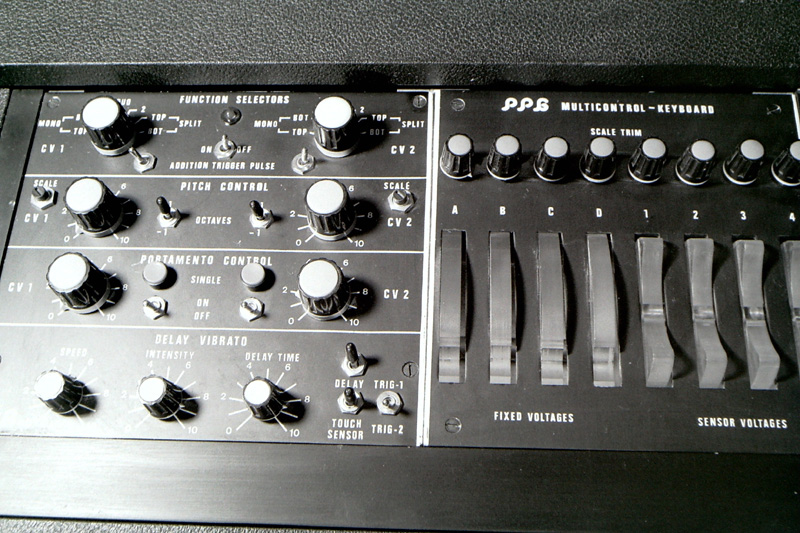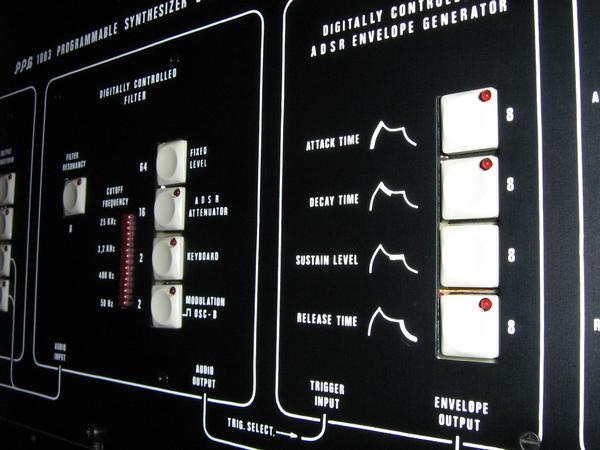The PPG Story
One day I got a call from a Berlin-based musician who said that he got my number from Mr. Funk, and that I'd create extensions and special designs. It was Christof Franke! We met, and he told me about his ideas and his music. I was totally fascinated, and we discussed the whole evening.
I built some modules for him, and then met Peter Baumann, too, who wanted even more special things. They were especially interested in keyboards with more than one wheel, so that they could control up to eight different modulations directly from the keyboard during live concerts. (You have to keep in mind that this was before the times when sounds could be stored!)
The photo shows a closeup of such a keyboard. It had 8 wheels, which could be adjusted to arbitrary voltage ranges.
 Tangerine Dream had their first successes at that time and invested quite a lot into their instruments.
Tangerine Dream had their first successes at that time and invested quite a lot into their instruments.
(By the way, it isn't true that TD had a share in PPG, or supported me directly, like you can sometimes read)
Technologically, I had made noticeable advances. One big problem with analog synthesizers always was the inherent pitch instability. Even with the Moog models, this was the case. Especially with temperature changes, the devices stopped being in tune!
That's why I had the idea to create digital oscillators. The first synth with DCOs (digitally controlled oscillators) was the 1020. Additionally, it had the advantage to provide more waveforms than the Moog (or all other analog synthies that only had sawtooth, pulse and triangle waves). Using digital technology, it was no problem to create waveforms with different sound spectra.
Another problem of the synths at that time had been that you couldn't store the settings. Some users had created patch sheets on paper where they entered the values.
Based on the 1020, I created a synth that could do without any knobs; you had to enter all values with digital pushbuttons instead. Of course, this was unusual and work-intensive, but it had the immense advantage that you could store the complete setup.
Unfortunately, this was before microprocessors became available, so that I had to create the complete digital part from individual ICs (and this made it rather error-prone, unfortunately).
I called this model: PPG 1003 "Sonic Carrier" (that didn't mean "career", but rather carrier or conveyor of sounds).
There were two versions available: a standalone one with keyboard, and one that could be put into the modular system (it had the same form factor). Unfortunately, this made the keyboard version rather bulky. All in all, only 16 pieces were sold. But it was the first synth worldwide that was fully "memory-programmable".
In 1977, I drove to the "Frankfurter Musikmesse" for the first time - without having reserved a booth, however. The idea was simply to drive to Frankfurt with a modular system, a 1003, and a 1020 and to try to meet traders and musicians there, to show them the devices in my hotel room!
So I went there with Detlev Reshöft (a Hamburg-based musician who already owned a 1020) and my devices in his VW Band Bus. Somehow we managed to lure some people from "Musik Market" (or something like that) into looking at the devices. They were just in the process of opening some stores in Germany, and wanted to roll up the market with "Cash+Carry" campaigns. Anyway, they ordered some devices.
After they had arrived in the shops, one of the shop assistants called me from Offenburg and complained about the situation that he didn't find really satisfying. It was Wolfgang Düren. After some days or weeks he had convinced me to stop the deal with "Music Market" and rather open a real PPG distribution with him!
No sooner said than done, a company was formed, and Düren could start.
Eines Tages bekam ich einen Anruf von einem Musiker aus Berlin, der sagte er hätte meine Nummer von Herrn Funk bekommen mit der Information, ich würde Erweiterungen und Spezialanfertigungen machen. Es war Christof Franke! Wir trafen uns dann und er hat mir von seinen Ideen und seiner Musik erzählt. Ich war total fasziniert und wir haben den ganzen Abend diskutiert.
Ich habe einige Module für ihn gebaut und lernte dann auch Peter Baumann kennen, der noch speziellere Sachen haben wollte. Besonders waren sie an Keyboards interessiert, die mehrere Wheels hatten, sodass man beim Live Konzert bis zu 8 Modulationen direkt vom Keyboard aus steuern konnte (man muss bedenken, dass das vor der Zeit war, als man Klänge abspeichern konnte!). Tangerine Dream hatten damals ihre ersten grossen Erfolge - speziell in den USA - und haben sehr viel in ihre Instrumente investiert (es stimmt übrigens nicht, das TD sich an PPG beteiligt, oder mich direkt unterstützt haben, wie es manchmal zu lesen ist).
Technologisch war es bei mir auch deutlich vorangegangen. Ein Problem mit den
analogen Synthesizern war immer die Stimminstabilität. Das war auch bei den moog Modellen der Fall. Besonders bei Temperaturschwankungen, fingen die Geräte an, nicht mehr oktavrein zu sein! Daher hatte ich die Idee, die Oscillatoren digital aufzubauen.
Der erste Synth mit DCO's (digitaly controlled Oscillator) war der 1020. Er hatte ausserdem den Vorteil, über mehr Wellenforman zu verfügen als der moog (oder alle analogen Synthis, die nur Sägezahn, Puls und Dreieck-Wellen hatten). Mit der Digitaltechnik war es kein Problem, Wellenformen zu erzeugen, die über andere Spectren verfügten.
Ein anderes Problem bei den Synths war bis dahin gewesen, dass man die Einstellungen nicht abspeichern konnte. Manche User hatten sich Listen gemacht, wo die Werte eingetragen wurden.
Ich hab dann - auf dem 1020 aufbauend - einen Synth entwickelt, der ganz ohne Drehknöpfe auskam. Stattdessen musste man alle Parameter mit digitalen Tastern eintippen.
Hier ein ausschnitt von einem 1003 panel (courtesy Fabio Piazzo)
 Das war natürlich zunächst ungewöhnlich und aufwendig, hatte aber den grossen Vorteil, dass man die gesamte Einstellung abspeichern konnte. Da es zu der Zeit noch keine Microprozessoren gab, musste ich den ganzen Digitalteil aus einzelnen IC's zusammensetzen (leider es war auch entsprechend fehleranfällig).
Das war natürlich zunächst ungewöhnlich und aufwendig, hatte aber den grossen Vorteil, dass man die gesamte Einstellung abspeichern konnte. Da es zu der Zeit noch keine Microprozessoren gab, musste ich den ganzen Digitalteil aus einzelnen IC's zusammensetzen (leider es war auch entsprechend fehleranfällig).
Ich nannte dieses Modell: PPG 1003 "Sonic Carrier" (damit war nicht "Karriere" gemeint, sondern Träger oder Beförderer der Sounds).
Es gab zwei Versionen: eine stand-alone mit Keyboard sowie eine, die in das Modulsystem eingebaut werden konnte (es hatte denselben Formfaktor). Die Keyboard-Version ist dadurch allerdings recht gross geworden.
Insgesamt wurden nur 16 Stück verkauft, aber es war der erste Synth überhaupt, der voll "speicher-programmierbar" war.
1977 fuhr ich das erstemal auf die "Frankfurter Musikmesse", allerdings ohne einen Stand gebucht zu haben. Die Idee war, einfach mit einem Modulsystem, einem 1003 und einem 1020 nach Frankfurt zu fahren und dort zu versuchen, Händler und Musiker zu treffen, um ihnen die Geräte im Hotelzimmer vorzuführen.
Ich fuhr also mit Detlev Reshöft (einem Hamburger Musiker, der auch schon einen 1020 hatte) in seinem VW-Band-Bus und den Geräten los. Irgendwie schafften wir es, Leute von "Musik Market" (oder so ähnlich) dazu zu bringen, sich die Geräte anzusehen.
Sie waren gerade dabei, mehrere Läden in Deutschland aufzumachen, und wollten mit "Cash+Carry"-Aktionen den Markt aufmischen. Auf jeden Fall bestellten sie ein paar Geräte. Als diese dann in den Shops angekommen waren, rief mich einer der Verkäufer aus Offenburg an und erzählte mir die ganze Situation, die er nicht sehr befriedigend fand. Es war Wolfgang Düren. Nach ein paar Tagen oder Wochen hatte er mich überzeugt, die Sache mit "Music Market" aufzugeben und lieber mit ihm zusammen einen echten PPG-Vertrieb aufzumachen!
Gesagt, getan - es wurde eine Firma gegründet und Düren konnte loslegen.